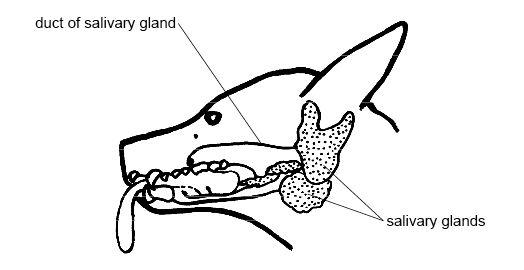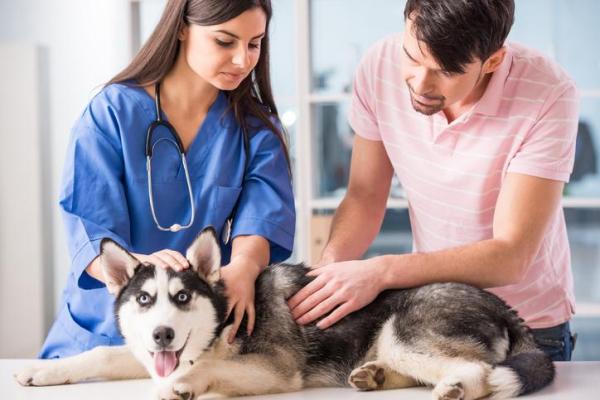
Petting our dog is an enjoyable activity which is healthy for us, for the dog and for our bond together. There are many places a dog may like to be petted and under the chin is one of the most common. If we are petting them on the neck and we find lumps, we might wonder can dogs get the mumps? Since mumps is a disease common to humans, we might also wonder if mumps can be transferred to our dog.
At AnimalWised we reveal that dogs can get the mumps, but it is very uncommon. Although unlikely, we should look at the causes, symptoms and treatment of mumps in dogs so we can both know what we do if they occur and what we can do to prevent it happening in the first place.
What is mumps in dogs?
As with human beings, mumps is the term used for an inflammation of the parotid salivary glands and is also known as parotitis. The parotid glands are under each ear of our dog, specifically at the base of the ear cartilage, and are in a tilted ‘V’ shape.
Saliva production is controlled by four major pairs of salivary glands. They are:
- Parotid salivary glands
- Submandibular salivary glands
- Sublingual salivary glands
- Zygomatic salivary glands
Felines have a fifth pair known as the molar salivary glands, but these are not present in canines. Saliva contains an enzyme called amylase which breaks starch down into glucose. This is the beginning of the digestive process and is vital for a dog's well-being.
You may have heard of another type of mumps in dogs known as puppy mumps or puppy strangles. This is something which variably refers to juvenile cellulitis, juvenile pyoderma or juvenile sterile granulomatous dermatitis. This disease affects dogs which are less than four months of age. It causes edema (fluid accumulation) in the muzzle and periocular region. It is not the same as parotitis.
When puppy mumps develop sufficiently, crusted pustules will appear around the outer ear. This can affect the vertical part of the ear canal, resulting in otitis or the inflammation of the ear. If untreated, it can lead to hair loss, skin hardening and ulcerations on the skin of their snout. The mandibular lymph nodes may swell and can also ulcerate. Deep inflammation (cellulitis) can affect the hair follicles and lead to scarring.
Causes of mumps in dogs
Parotitis in dogs can be caused by the following:
- Trauma: although vaccinations are safe for dogs, there are rare occasions when the inoculation can cause inflammation which affect the parotid glands.
- Secondary disease: when the dog suffers from another disease such as pharyngitis or sialolithiasis (salivary stones stuck in the parotid duct), a secondary infection of parotitis can occur. It is also possibly a consequence of canine distemper virus.
- Viral spread: it is possible mumps in dogs can be caused by the same virus which produces mumps in humans. It is rare, but there have been cases where close contact has resulted in a viral load spreading. Transmission can occur due to contact with fomites (objects containing a viral load), airborne from the person or urine. It is also a disease which is transmissible to cats, again in rare circumstances.
The virus that causes mumps belongs to the same family as the disease known as canine distemper, from the family of Paramyxoviridae viruses. Unlike the genus to which distemper belongs, which is Morbillivirus, the mumps virus belongs to the genus Rubulavirus. It is an RNA virus that is isolated from saliva, cerebrospinal fluid, urine, brain matter, blood and other tissues.

Symptoms of mumps in dogs
The mumps virus first affects the parotid glands and causes painful swelling. It is the increased size of the swollen glands which gives them the characteristic appearance of mumps. A dog affect by mumps will exhibit the following clinical signs:
- Varying levels of inflammation on the neck
- Redness and/or pus in the glands
- Hardening of the glands due to increased connective tissue
- Fever
- Pain
- Weight loss
- Decay
- Lethargy
Depending on the severity of the disease, inflammation to the submandibular glands can be prolonged and even affect the facial nerve. In these cases, facial paralysis may occur. In the event we observe any of the symptoms of mumps in dogs, it is essential to go to the veterinarian immediately.
Diagnosis of mumps in dogs
Mild parotitis can be confused with inflammation of the immediate connective tissue or subparotid lymph nodes. It may also be the case that the lymph nodes are affected by the parotitis. By using ultrasound scans, we can differentiate mumps in dogs with other pathologies such as adenitis, abscesses or the aforementioned salivary stones.
The diagnosis of parotitis is also aided by checking the dog's medical history. We need to see in which context the swelling began and of there is an incident where they have come in contact with a person or another animal with mumps.
The next step will be for the veterinarian to examine the neck area of the dog to assess the severity of the inflammation. This will also help determine if the inflammation is in the parotid glands or another area. They can also observe to see if the swelling has spread to other tissues or nerves.
Once parotitis is believed to be the likely cause, the veterinarian will issue a blood test for dogs:
- The blood count will show normal or a decreased total leukocyte count with an increase in lymphocytes.
- If the amount of amylase in the blood serum is increased from 269-1462 U/l, a salivary gland disease will be suspected (parotitis or glandular calculi). However, this could also be a sign of pancreatic disease, oliguric kidney disease or disorders of the intestines or liver.
Samples of saliva, pharyngeal exudate or oral mucosa will be obtained. This will be to isolate the genetic material of the virus with a PCR test or to check for antibodies against other infections.
Can you cure mumps in dogs?
Since mumps in dogs is a viral disease, there is no specific medicine which can sure it. Treatment of mumps on dogs, therefore, relies on managing the symptoms of the disease. These include:
- Antipyretics and anti-inflammatories to lower fever and inflammation.
- Subcutaneous or intravenous fluid therapy if severe dehydration occurs.
- A soft food diet, as swallowing is made more difficult, and plenty of water.
- Rest.
In the case of a secondary bacterial infection, antibiotics are administered and abscesses should be drained early if they exist.
Prognosis of mumps in dogs
In general, the prognosis is good and the dog should be clear of mumps within two weeks after symptoms arise. We need to go to a veterinarian to make the correct diagnosis for our dog and see which treatment options are necessary.
Since mumps in dogs are very contagious to other dogs, we need to separate them until they are no longer infectious. Although humans may be able to give mumps to dogs, there are no documented cases of dogs giving mumps to humans. This may be in part due to the fact humans are regular inoculated against the mumps. There is no such preventive mumps vaccine for dogs.
Since mumps are a rare cause of swelling, we should also look at other possible reasons your dog has lumps on their neck.

Can you treat mumps in dogs with home remedies?
There is no clinical drug to stop the virus and there is no home remedy which can do it either. However, there are things we can do at home which will help the dog manage their symptoms. One helpful tip is to apply cold compresses to the affected swollen area. Some suggest that aloe vera or chamomile might provide anti-inflammatory properties, but there is little clinical evidence to suggest its effectiveness in a topical application.
Any complementary medicine should be approved by your veterinarian before administration. The wrong treatment can be worse than no treatment.
This article is purely informative. AnimalWised does not have the authority to prescribe any veterinary treatment or create a diagnosis. We invite you to take your pet to the veterinarian if they are suffering from any condition or pain.
If you want to read similar articles to Can Dogs Get the Mumps?, we recommend you visit our Viral diseases category.
- Ausina,V., & Moreno, S. (2005). SEIMC Treatise on Infectious Diseases and Clinical Microbiology. Panamericana Medical Publishing House.
- Mumps in dogs. Available at: https://perritoshc.mx/index.php/k2-extra-field-groups/perritos-y-mascotas/item/5589-paperas-en-perros
- Autonomous University of Barcelona. Salivary gland diseases. Available at: https://ddd.uab.cat/pub/llibres/1914-1930/60248/patterespanidom_a1914-1930t2f1r1x2.pdf